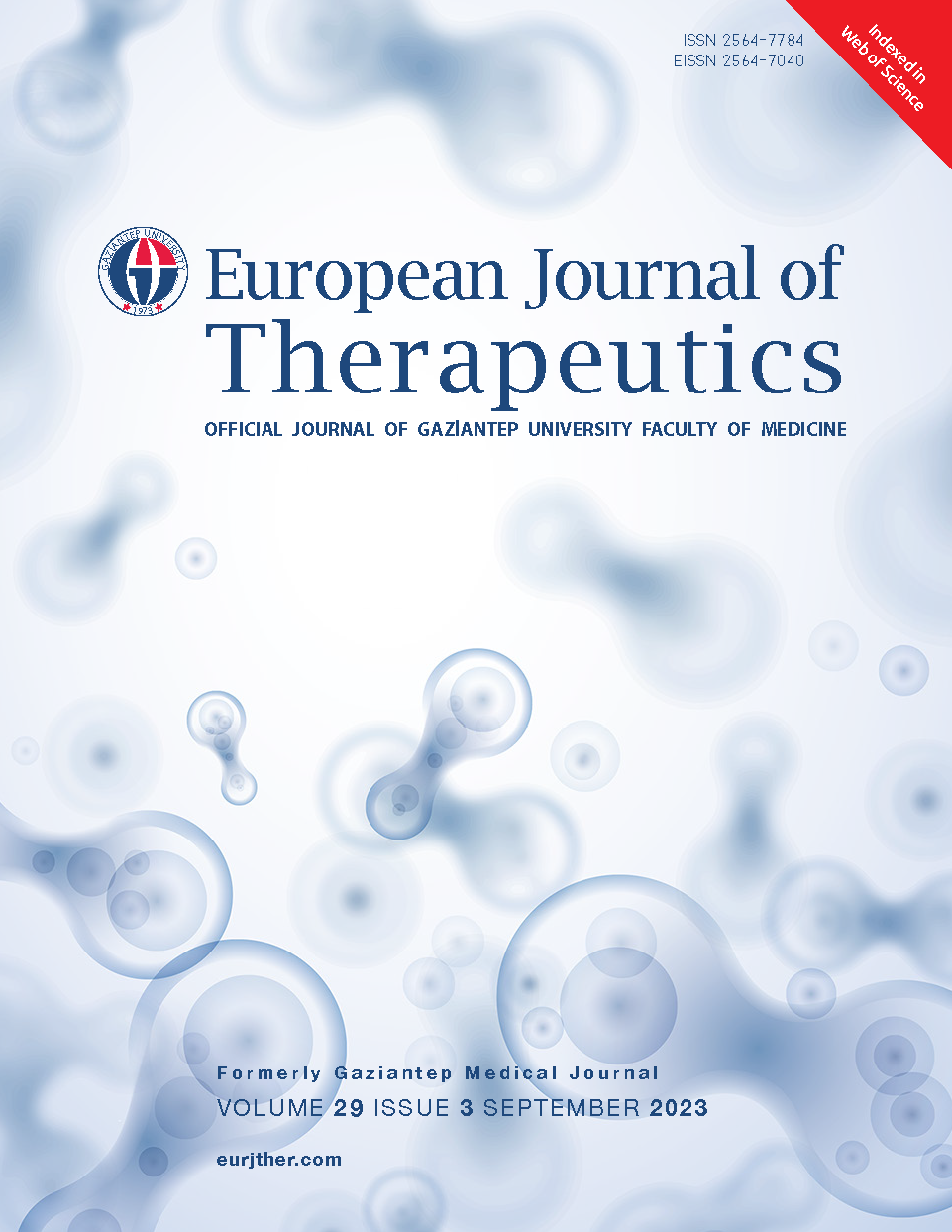Breast Stereotactic Excision Results
DOI:
https://doi.org/10.58600/eurjther1825Keywords:
Malignancy, mammography, microcalcification, stereotactic excisionAbstract
Objective: Suspicious microcalcifications detected in mammographic examinations may appear as early signs of breast malignancies. Microcalcifications that appear only on mammography and are not accompanied by any ultrasonographic mass should be excised after marking with a stereotactic wire, and pathological examination should be performed. In this study, we aimed to analyze the stereotactic biopsy results and share their findings.
Methods: Lesions with suspicious microcalcifications on mammography (Figure 1) and in which no mass image was detected in the ultrasonographic response were evaluated retrospectively between January 2016 and December 2022. Excision was applied to the patients after marking with mammography and stereotactic wire. Removal of the suspicious microcalcification area was confirmed by radiography of the specimen in all patients. Pathological examination results of the patients, whether re-excision was made, tumor diameter in cases with malignancy, and follow-up periods of the patients were evaluated.
Results: A total of 54 patients who underwent excision due to microcalcification were evaluated in the study. Malignancy was detected in 15 (27.7%) patients. The most common ductal carcinoma in situ (DCIS) was detected. Re-excision was performed in 4 (26.6%) patients, and mastectomy was performed in 2 (13.3%) patients with malignancy. The median tumor diameter of malignant lesions was 9 mm. The mean follow-up period of the patients was found to be 42.46+16.44 months.
Conclusion: Suspicious microcalcification areas detected in mammographic examinations, lack of ultrasonographic visibility, and biopsy with another minimally invasive method should be excised after marking with a stereotactic wire. This procedure is an effective method that allows early diagnosis of malignancies.
Metrics
References
Wilkinson L, Thomas V, Sharma N (2017) Microcalcification on mammography: approaches to interpretation and biopsy. Br J Radiol 90:20160594. https://doi: 10.1259/bjr.20160594.
Mannu GS, Wang Z, Broggio J, Charman J, Cheung S, Kearins O, et al. (2020) Invasive breast cancer and breast cancer mortality after ductal carcinoma in situ in women attending for breast screening in England, 1988-2014: population based observational cohort study. BMJ 27;369:1570. https://doi: 10.1136/bmj.m1570.
DeSantis C, Ma J, Bryan L, Jemal A (2013) Breast cancer statistics, CA Cancer J. Clin. 64(1);52–62. https://doi.org/10.3322/caac.21203
Shehata M, Grimm L, Ballantyne N, Lourenco A, Demello L, Kilgore M et al. (2019) Ductal Carcinoma in Situ: CurrentConcepts in Biology, Imaging, and Treatment. J BreastImaging 1(3):166-176. https://doi: 10.1093/jbi/wbz039
Barreau B, Mascarel I, Feuga C, MacGrogan G, Dilhuydy M, Picot V et al. (2005) Mammography of ductal carcinoma in situ of the breast: review of 909 cases with radiographic–pathology correlations. Eur J Radiol 54(1):55-61. https://doi: 10.1016/j.ejrad.2004.11.019
Peintinger F (2019) National Breast Screening Programs across Europe. BreastCare (Basel) 14(6):354-358. https://doi: doi: 10.1159/000503715.
Besic N, Zgajnar J, Hocevar M, Rener M, Frkovic-Grazio S, Snoj N, Lindtner J (2002) Breastbiopsywithwirelocalization: factors influencing complete excision of nonpalpable carcinoma. Eur Radiol 12(11):2684-9. https://doi: 10.1007/s00330-002-1331-4.
Tot T, Gere M, Hofmeyer S, Bauer A, Pellas U (2021) The clinical value of detecting microcalcifications on a mammogram. Semin CancerBiol 72:165-174. https://doi: 10.1016/j.semcancer.2019.10.024.
Jeffries DO, Dossett LA, Jorns JM (2017) Localization for Breast Surgery: The Next Generation. Arch Pathol Lab Med 141(10):1324-1329. https://doi:10.5858/arpa.2017-0214-RA.
Cheang E, Ha R, Thornton CM, Mango VL (2018) Innovations in image-guided preoperative breast lesion localization. Br J Radiol 91(1085):20170740. https://doi: 10.1259/bjr.20170740.
Tate PS, Rogers EL, McGee EM, Page GV, Hopkins SF, Shearer RG, et al. (2001) Stereotactic breast biopsy: a six-year surgical experience. J KyMedAssoc 99(3):98-103.
Langhans L, Jensen MB, Talman MM, Vejborg I, Kroman N, Tvedskov TF (2017) Reoperation Rate in Ductal Carcinoma In Situ vs Invasive Breast Cancer After Wire-Guided Breast-Conserving Surgery. JAMA Surg 1;152(4):378-384. https://doi: 10.1001/jamasurg.2016.4751.
Salvatorelli L, Puzzo L, Vecchio GM, Caltabiano R, Virzì V, Magro G (2020) Ductal Carcinoma In Situ of the breast: An Update with emphasis on Radiological and Morphological Features as Predictive Prognostic Factors. Cancers (Basel) 6;12(3):609. https://doi: 10.3390/cancers12030609.
Wapnir IL, Dignam JJ, Fisher B, Mamounas EP, Anderson SJ, Julian TB, et al. (2011) Long-Term Outcomes of Invasive Ipsilateral Breast Tumor Recurrences After Lumpectomy in NSABP B-17 and B-24 Randomized Clinical Trials for DCIS. J. Natl. CancerInst 103:478–488. https://doi: 10.1093/jnci/djr027
Iatrakis G, Zervoudis S (2021) Epidemiology of Ductal Carcinoma In Situ. Chirurgia (Bucur) 116:15-21. https://doi:10.21614/chirurgia.116.5.suppl.S15.
Wilkinson L, Thomas V, Sharma N (2017) Microcalcification on mammography: approaches to interpretation and biopsy. Br J Radiol 90(1069):20160594. https://doi: 10.1259/bjr.20160594.
Downloads
Published
How to Cite
License
Copyright (c) 2023 European Journal of Therapeutics

This work is licensed under a Creative Commons Attribution-NonCommercial 4.0 International License.
The content of this journal is licensed under a Creative Commons Attribution-NonCommercial 4.0 International License.


















